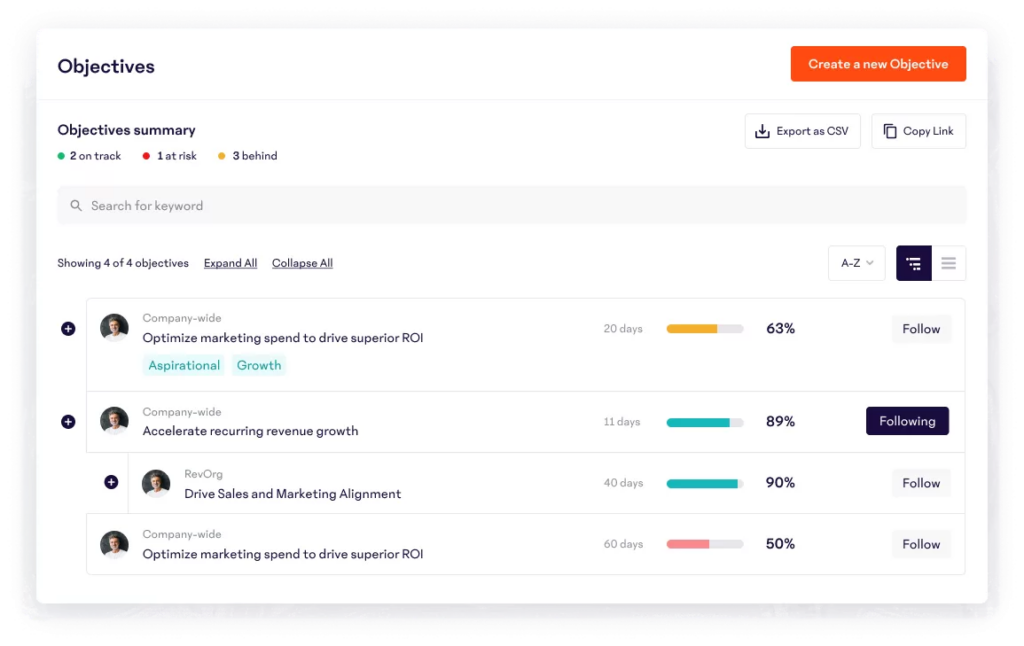8 Steps to Improve Employee Productivity in 2024
Knowing how to improve employee productivity is on every leader’s mind as organizations navigate return-to-office mandates, economic instability, and the impact of inflation.
If you want to get the most out of your employees and support work efficiency, follow along for eight steps to improve productivity in the workplace.
1. Strategically align employee goals
Align employee goals with business objectives to help your direct reports understand how their work fits into a more comprehensive framework and contributes to results.
This improves productivity because employees know how their work impacts a broader goal and contribution, which helps them stay engaged and motivated.
Set aside time with direct reports to review their goals for the next quarter or year and ensure they coordinate with overarching objectives. For example, if a business goal is to enter a new market, align employee goals with that aim.
Use a performance management system to track and measure goals and ensure consistent alignment between leadership and employees.

2. Define clear key performance indicators
Set key performance indicators (KPIs) to help employees clearly know what’s expected of them regarding individual performance and how they contribute to wider company goals.
Clear expectations mean employees understand their roles and responsibilities, which reduces ambiguity and helps promote a focused approach to performance and work.
For example, if a business goal is to enter a new market, a KPI could be leads generated, which would measure the volume of potential new business customers the employee brings to the company.
KPIs are also measurable criteria for evaluating individual performance because they provide quantitative and qualitative insights that assess how well an employee meets a specific goal or objective.
Measure KPIs and use this metric to assess performance results, create fair and objective evaluations, and provide value in performance appraisals, feedback sessions, one-on-ones, and career development discussions.
3. Implement employee feedback mechanisms
Regular feedback gives team members insight into their performance and highlights areas where they’re succeeding alongside areas for improvement. This helps employees understand expectations and enables them to make adjustments to their performance while improving hard and soft skills.
Feedback sessions also help contribute to learning and development because they provide employees with a path for professional growth.
Additionally, regular acknowledgment of contributions means employees feel valued and motivated to perform at their best.
Use feedback discussions to discuss goal setting, career planning, and development plans.
A performance management tool will help facilitate ongoing communication between employees and managers and ensure open communication where all parties feel in the loop.
Further reading: 9 Tips For How To Give Effective Employee Feedback
4. Provide training and development opportunities
When employees develop new skills or improve existing ones, they become more proficient in their day-to-day roles, which helps increase productivity.
Provide training and development opportunities to assist employees in their professional development. For example, identify skills gaps through continuous feedback and one-on-ones, then create a clear learning path that bridges the gap.
Don’t forget to run programs that develop leadership skills and manager enablement to keep yourself invested in your own professional development and ensure you can fulfill the demands of a leadership role.

5. Hold regular performance reviews
A performance review assesses employee contributions toward a company and provides them with fair and actionable feedback that supports their career development path.
Use the time in a performance review to share how well employees meet their KPIs and explain how they contribute to business success. This helps employees understand how they impact the company, which helps drive high performance and engagement.
Conduct a performance review frequently. Otherwise, you’ll miss out on an opportunity to provide guidance, mentorship, and learning opportunities for the employee. We recommend holding performance reviews at least quarterly.
Use the information you tracked while setting KPIs, holding feedback sessions, and one-on-ones to provide the basis for the performance review. When you use a performance management tool like 15Five, all this information is stored in one platform, helping produce effective, holistic performance reviews that are easy to manage.
6. Develop wellness programs
Wellness programs give employees more healthcare options at work to help them feel happier, healthier, and more productive while aiming to reduce stress and prevent absenteeism.
Stress has a significant impact on businesses, with Gallup finding record high volumes of stress in the global workforce and the American Institute of Stress stating that 40% of workers say their job is very or extremely stressful.
Develop wellness programs (for example, implementing a subsidized or complimentary gym membership or gifting access to a meditation app) and use a tool like 15Five to gather employee feedback on their effectiveness.
7. Hire a diverse workforce
Building a diverse and inclusive business creates a workplace where people feel they belong and are appreciated for being themselves, which helps improve employee happiness, engagement, and trust.
A healthy, diverse workplace with a wide range of experiences also supports creative, innovative thinking and problem-solving, helping boost productivity.
Here are a few tips to help improve diversity in the workplace:
- Write inclusive job descriptions that avoid gender-specific language
- Widen your search to include diverse talent pools or groups
- Design an easily accessible and inclusive application process
- Allow for reasonable accommodations and adjustments at interviews and in the workplace
- Create a diversity, equity, and inclusion committee
- Hold diversity awareness workshops or training sessions for leaders and senior management
Further reading: 6 Guiding Principles of Diversity, Equity, and Inclusion and Why You Need to Focus on Them.
8. Focus on data-driven decision making
The best way to improve employee productivity? Ensure your business makes decisions using data, not feeling.
When you make decisions based on feelings, this could lead to bias in the workplace and have a significant impact on the success of your business.
When you use a performance management tool to goal set, define clear KPIs, engage in employee feedback sessions, and provide training opportunities, you gain valuable insights and data to make informed decisions about the future of your organization vs. relying on guesswork and gut feeling.
Supercharge productivity with 15Five
Optimizing employee productivity is crucial for businesses navigating today’s challenges. By implementing the eight steps outlined above, leaders can foster a culture of efficiency and engagement within their organizations. However, to truly streamline these processes and maximize results, leveraging advanced tools like 15Five can make all the difference. 15Five offers a comprehensive platform for performance management, feedback mechanisms, and data-driven decision-making, all in one accessible interface. With a commitment to continuous improvement and employee well-being, 15Five empowers leaders to unlock their team’s full potential. Don’t just take our word for it—experience the difference firsthand by booking a demo today.




